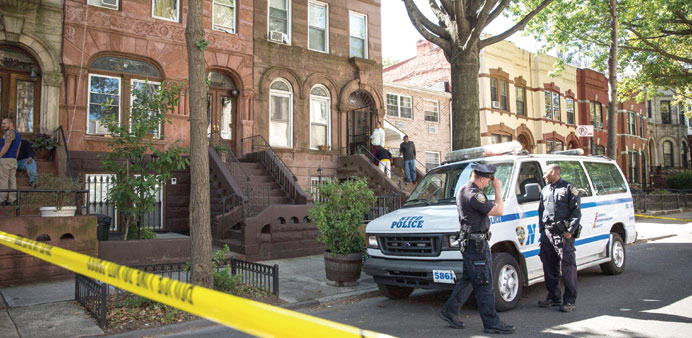Policemen stand guard outside the home of Cathleen Alexis, the mother of Washington Navy Yard shooter Aaron Alexis, yesterday in the Bedford-Stuyvesant neighbourhood of the Brooklyn borough of New York City.
By Frank Fuhrig/DPA/Washington
Three of the people wounded in Monday’s Navy Yard shooting were rushed to the Washington Hospital Centre, where Doctor Janis Orlowski led trauma teams working all day and into the night.
One woman was wounded in the shoulder, another woman on the scalp and hand, and a man - a Washington cop who may have been among the first officers at the scene - suffered severe wounds to both legs.
“Their chances for survival are very good,” said Orlowski, the hospital’s chief medical officer.
However, Orlowski conceded that Monday’s violence had left even her hardened and emergency room colleagues shaken. In a press briefing, she described how the victims talked about hearing rapid, semi-automatic gunfire.
Noting that gunshot wounds were nothing new at the hospital, she took a broader look at the “senseless trauma” commonplace in US society: “There’s something evil we as Americans need to work to try to eradicate.”
Suspected Navy Yard gunman Aaron Alexis killed 12 people and wounded eight others before police apparently shot him dead after a more than 30-minute running gun battle through a purported high-security building.
Washington, once the murder capital of the US, has become much safer in the last 20 years, but street crime still grips the federal city’s most impoverished neighbourhoods, sending a steady stream of victims to local emergency rooms, where staffs are expert at treating gunshot wounds.
DC’s delegate to Congress, Eleanor Holmes Norton, said she called for a moment of silence on the floor of the US House of Representatives yesterday.
“But we are not going to be silent about the tragedy that occurred here today,” she said, adding that there were outstanding questions from many in the city of 620,000 people who have been plagued by gun violence.
The neighbourhood where Monday’s shooting occurred has been undergoing regentrification in recent years. A new baseball park for the city’s professional team opened in the area five years ago and new housing units and transportation facilities also have been built.
Monday’s massacre put the city on edge, snarled traffic and raised security at most offices and public facilities. The tension was reminiscent of the Beltway sniper killings in which 10 people were slain in October 2002. Those shootings took place in and around Washington and its suburbs over a three-week period.
Officials investigating the DC shooting said they didn’t know what the motive was, adding they hadn’t completely ruled out terrorism.
The year 2012 saw a seeming spike in mass shooting incidents in the US: 12 died in a shooting inside a cinema in Aurora, Colorado, and a gunman invaded an elementary school in Newtown, Connecticut, killing 20 children and six educators. The incidents sparked fierce debate over both US gun laws and the mental health system.
Man throws firecrackers over White House fence
A man threw firecrackers over the White House’s north fence on Monday, just hours after a shooting rampage in the US capital in which 13 people died, the US Secret Service said.
Uniformed agents sealed off the area in front of the presidential mansion and ordered journalists in the driveway in front of the West Wing to move inside the building.
With the capital on high alert after the earlier shootings, reaction to the firecrackers was immediate, with some people tweeting that shots had been heard.
“There have not been shots outside the White House,” said Secret Service spokesman Ed Donovan.
Video of the incident showed agents apprehending a man dressed in shorts and a short-sleeve shirt before leading him away.
The man, identified as Alexander Sahagian, has been arrested, a law enforcement official said. The charge was likely to be throwing projectiles.

